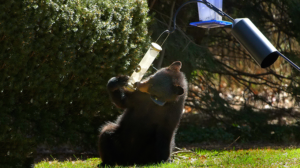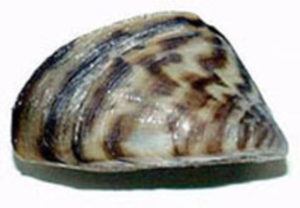Karen and Mark Karlberg of Becket have been having problems with black bears lately. It started on Christmas day but worsened in early February when it really warmed up. In spite of taking their bird feeders in, one bear actually broke in through the fence which holds their llamas. He tore the fence back and got to where they had some suet and birdseed. The bear “freaked out” the llamas and their barnful of chickens and then tore back another piece of fencing to get out into the swamp. The Karlbergs repaired the fence but the bear kept coming back every day.
There is one really large one, about 350 lbs., and a smaller one with a white chest. The bears are smart breaking into the fencing and getting close to their chickens and they are becoming a worry. They are hungry and are becoming brave, coming back 3 days in a row. Anytime bears leave their dens, they are mighty hungry and they will go where there is food.
It seems that with this past warm winter, they didn’t want to stay in hibernation. Karen thinks it has to do with Global Warming, (Climate Change, if you prefer). The weather this winter has been very erratic, with one day reaching near record warm temperature and the next day the thermometer plunges down to what winter weather is supposed to be. 
The Karlbergs were at a loss as to what to do about the bears. Local hunters have a solution, but Karen has known these bears since they were youngsters and doesn’t want them killed. So far, they haven’t killed her llamas but have come too close for comfort, trying to get into their barn. They have used an air horn which warded them off for a while but then they started to ignore it. They have used a bright 50-watt spotlight and everything else they could think of. Their neighbor in Otis also has a problem with bears and has even thrown firecrackers at them.
The Karlbergs contacted DFW Western District Supervisor Andrew Madden to see what he suggested. One suggestion was to install an electric fence. (Click onto https://www.mass.gov for information on electric fences). Another suggestion was to use a paint ball gun on them. Well, it’s tough to install an electric fence this time of year so they went the paintball route.
That’s when Karen called me on February 22. She wanted to know where she could buy one. I suggested several local sports shops but they had already checked them all and nowhere in the Berkshires could they find any for sale. When Karen called me, they were on their way to NY to see if they could buy one there. She was frantic and wanted to buy one asap as a bear was at their house that very morning
Karen called me again on February 27 to tell me that one of the bears came back that morning. I asked her if they were able to shoot at them with the paintball gun. She said that it didn’t work and now has to return it for another. Karen loves animals and doesn’t want anything to happen to them but they are being destructive and this is a new trend. She is ok with taking the bird feeders down. If she gets lazy and doesn’t bring them in, then she deserves it. But this is different, there is something going on, they are hungry earlier.
Madden said that they sometimes advise the use of paintball guns as they provide a sting to the bear without skin penetration. They have seen and heard of people using pellet guns or small caliber weapons, but they can penetrate the skin and cause injury and infection which compromises the bear and may increase conflict by weakening the animal. Paintball guns are generally available and are one of the tools that a homeowner can use for aversive conditioning.
The Karlberg’s dog sometimes barks and chases the younger bear away, but it comes back every day. “Wildlife has changed, not changing, but changed” she said.
They are now thinking about having a professional install an electric fence, but they fear that the bears will go right through and not even feel it. Karen has received some advice; attach pieces of tinfoil on the fence with peanut butter on them. If any bears stop and smell the peanut butter, their noses may touch the tinfoil or wire and get a surprising jolt.
That makes perfect sense to me. I grew up on a small farm and my father would keep our cows in the barn in the winter. In the spring, he would bring them outside into our field. They were really happy getting outdoors and got pretty frisky and would sometimes jump and bolt right through our electric fences. Ultimately, he learned a trick. He would lead the cows up to the fence and touch their noses on the fence so that they would get a harmless shock. They never got too close to our fences the rest of the year.
So did the paintball gun work on the bears? Well, they decided to go with a larger air horn instead to see if that works. As of last Thursday, the bears have not returned, so the verdict is out.
Incidentally, MassWildlife, recently issued the following advisory: “Black bears are active and searching for food: take precautions. If you have bird feeders or if you keep chickens, bee hives, or livestock act now to keep bears wild and out of neighborhoods.”
Bears will often ignore seasonally available natural foods including skunk cabbage in favor of an easy meal at a backyard bird feeder. To avoid these problems, MassWildlife suggests that property owners be proactive and remove bird feeders and other potential food sources including garbage or open compost.
If you enjoy watching birds in your yard, MassWildlife suggests adding a water feature, growing native plants, shrubs, and trees to attract birds. Individuals should also secure bee hives, chickens, and livestock. Properly maintained electric fencing is the only way to protect chickens or bee hives from bears. Taking these actions may prevent the unnatural feeding of bears and other kinds of neighborhood wildlife.
There are at least 4,500 black bears in Massachusetts and their range is expanding eastward. Take action by educating yourself and your neighbors about proactive measures to avoid conflicts with bears. For more information about black bears in Massachusetts, visit mass.gov/bears.
Zebra Mussels discovered in a NY trout hatchery
The New York State Department of Environmental Conservation (DEC) recently announced that invasive zebra mussels were discovered in Delta Lake, which supplies water to DEC’s Rome Fish Hatchery this past January. DEC immediately launched an investigation and through subsequent water testing at the hatchery confirmed the presence of zebra mussel veligers (larvae) in an outdoor raceway. 
The Rome Hatchery is one of DEC’s largest hatcheries with annual production totaling nearly 160,000 pounds of brook, rainbow, and brown trout. DEC is currently developing short- and long-term strategies to limit the spread of this invasive species and ensure the hatchery returns to normal production. More information will become available as DEC continues to investigate and research the problem.
Out of an abundance of caution, DEC is adjusting its stocking regimen for 2020. Fish from the Rome hatchery will only be stocked in waters currently inhabited by zebra mussels. The DEC is currently determining the type and number of fish stocked into individual waterbodies this year; some waters may receive a reduction or increase in stocking, while other waters will not be stocked.
Alterations in stocking are also envisioned for 2021. DEC is investigating alternative options to maximize hatchery production so as many waters as possible can be stocked.
The Berkshires has many anglers who fish NY rivers such as the Ausable, Beaverkill, Esopus, Battenkill and other famed rivers over there. The adjusted stocking regimen may very well affect them. I tried contacting the DEC to see what, if any, effects there would be on one of my favorite rivers, the Ausable River near Lake Placid. So far, I have received no response.
Questions/comments: Berkwoodsandwaters@roadrunner.com. Phone: (413) 637-1818.
